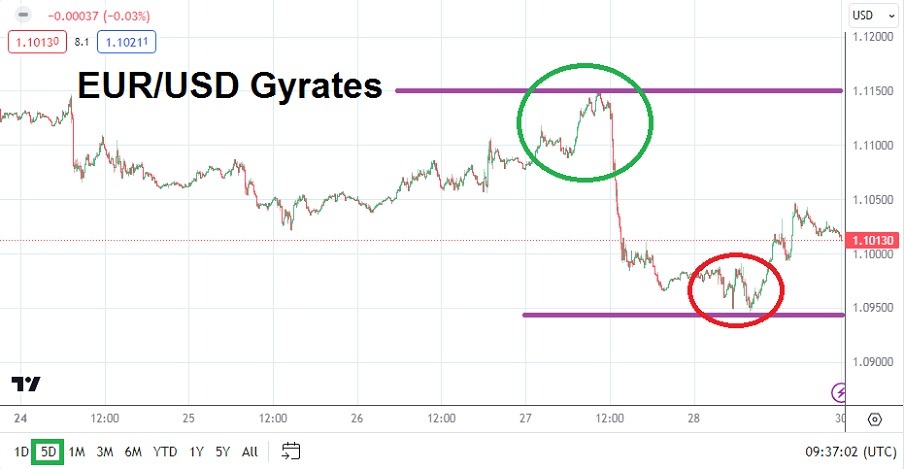The EUR/USD will begin tomorrow’s trading near the 1.10130 ratio. The EUR/USD hit a low around the 1.09450 ratio on early Friday, this after stumbling from its high for the week which was made on Thursday when the currency pair hit the 1.11500 level. The wide price range of the EUR/USD mirrored the results of other major currency pairs, this as the USD proved to be a volatile currency the last two days of the week. The optimistic charge upwards in the EUR/USD ran into a storm of selling on stronger U.S. growth numbers.
Top Forex Brokers
U.S. economic data provided a rather large upside regarding Gross Domestic Product on Thursday, after the stronger-than-anticipated growth numbers were published in the States, the USD began to gain strength. Bullish speculators of the EUR/USD were likely caught off guard late Thursday, but hopefully, risk management was being used to protect against volatility. After falling with fast price velocity on Thursday and into early Friday, the EUR/USD appeared ready to languish near values it had not touched since the 10th of July.
Inflation Data on Friday from the U.S provided more Volatility for EUR/USD Traders
However, before bullish EUR/USD traders were completely defeated on Friday, U.S. inflation data came in slightly below expectations. This outcome stirred Forex, including the EUR/USD before going into the weekend and created a slight reversal higher. The European Union will release manufacturing data from Germany and France this week and the numbers are expected to be close to last month’s results. But the U.S. will also release manufacturing data on Tuesday.
Trading early this week in the EUR/USD could prove to be choppy as financial institutions look for clear signals regarding the economic outlook. While the Fed and ECB both raised interest rates last week as expected, there seems to be a worry about the notion the U.S. economy is stronger than the European Union’s. This fear is creating the notion the U.S. Fed could stay more aggressive than anticipated. Yet, confusing results continue to be published in the U.S. and this week could provide more. On this Friday, the U.S. will present Average Hourly Earnings numbers and this inflation report could cause volatility for the EUR/USD.
Support Level and Inflation Data Will Effect Sentiment this Week
- The EUR/USD was able to finish last week above the 1.10000 level which is important for psychological reasons for most bullish traders.
- The level needs to remain durable as support, if it does not it could be a bad short-term signal for the EUR/USD near-term.
- The Non-Farm Employment Change numbers will be a major talking point for traders of the EUR/USD this week, but the inflation numbers via the outcome of the wage could prove more significant. A weaker inflation number could help the EUR/USD find buyers.
EUR/USD Weekly Outlook:
The speculative price range for EUR/USD is 1.09500 to 1.11700
The wide price range of the EUR/USD was rather astounding last week and a sign that financial institutions remain uncertain regarding their Forex outlooks. The EUR/USD did try to mount an attack upwards to challenge highs seen from the 13th until the 20th of July, but this failed in large measure and support proved quite vulnerable. U.S. economic data was certainly stronger than anticipated regarding growth, but bullish speculators of the EUR/USD may continue to look at U.S. inflation statistics and find hope for a potentially less aggressive Federal Reserve to emerge.
The start of this week should be watched by cautious traders, and Tuesday’s manufacturing data will be a lynchpin for the EUR/USD early. If the EUR/USD remains above the 1.10400 to 1.105000 levels early this week and goes into Thursday and Friday flirting with higher values, this could set the stage for a dramatic trading session as the jobs numbers come from the U.S. and are digested. The EUR/USD has shown signs of life and bullish activity since early June, but last week’s results poured some cold water on expectations. Technical traders should take a glance at U.S. data this week for short-term volatility indicators which could develop depending on outcomes. U.S. inflation statistics will likely be a key on Friday.


